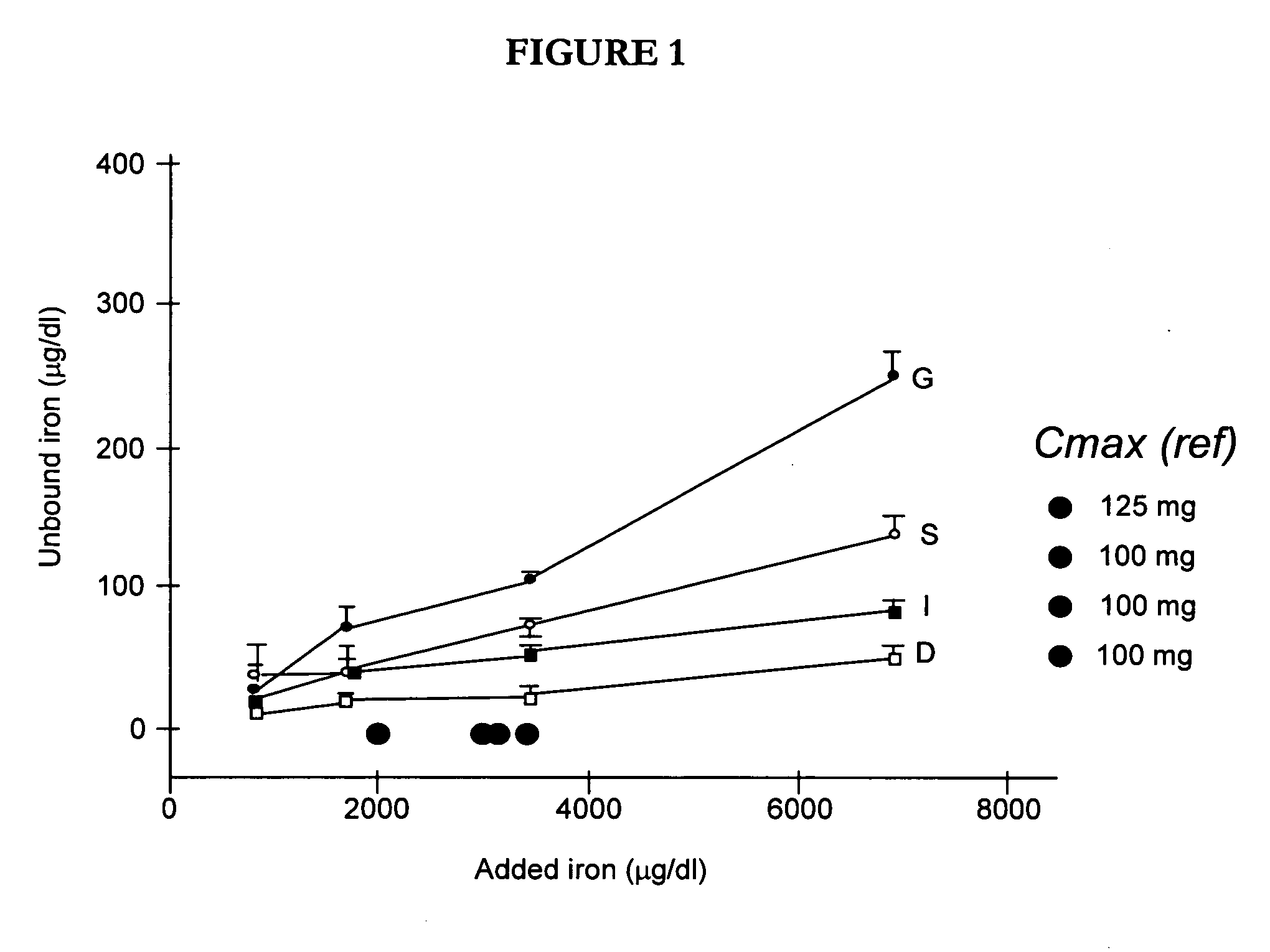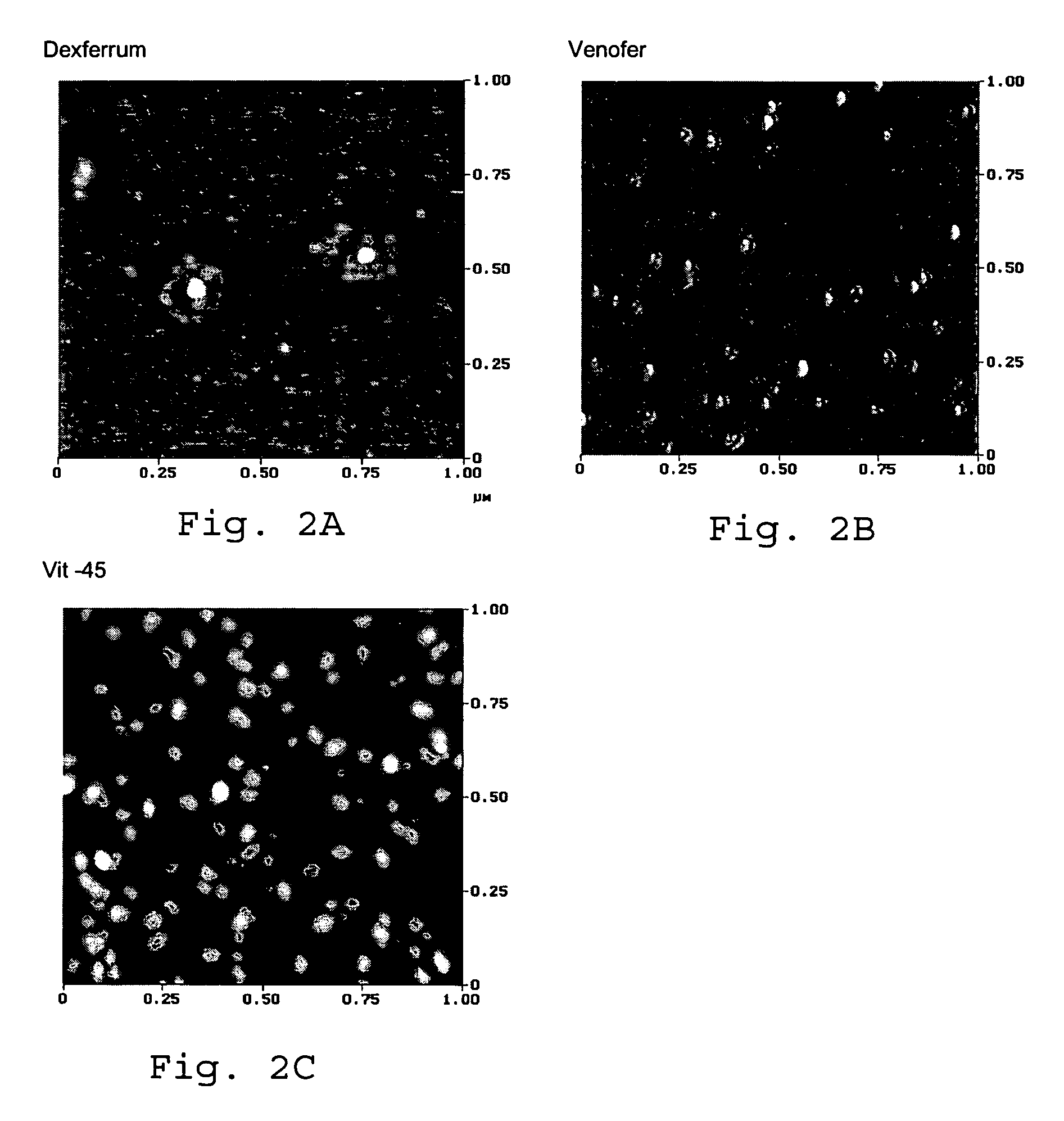Methods and compositions for administration of iron for the treatment of restless leg syndrome
a technology for restless legs and compositions, applied in the direction of drug compositions, biocides, plant/algae/fungi/lichens ingredients, etc., can solve the problems of increasing the quality of life of people who cannot sleep, increasing the difficulty of maintaining motor rest and limited cognitive stimulation, and increasing the difficulty of transportation (car, plane, train, etc.) to achieve the effect of safe and efficacious delivery of iron, faster labile iron release, and increased in vitro
- Summary
- Abstract
- Description
- Claims
- Application Information
AI Technical Summary
Benefits of technology
Problems solved by technology
Method used
Image
Examples
example 1
Iron Release Rates
[0067] Intravenous iron agents donate iron to transferrin indirectly through prior intracellular uptake, processing and controlled release. However, evidence that many adverse reactions to intravenous iron agents are dose-related, dose-limiting and vary by class of agent support the hypothesis that direct donation may also occur. Intravenous iron administration at sufficient doses may transiently over-saturate iron binding capacity, and that agents may vary in their potential to donate iron directly.
[0068] The ability of candidate iron complexes (intravenous injection preparations for ferric gluconate (also known as sodium ferric gluconate in sucrose, Ferrlecit®)), iron sucrose (iron sucrose for injection, Venofer®) and both available formulations of iron dextran (INFeD® and Dexferrum®) to donate iron to transferrin in serum in vitro was assayed. A series of dilutions of the iron agents were added to fresh serum, passed over an alumina column to remove iron-sugar...
example 2
Tests to Diagnose and Evaluate RLS Symptoms and Monitor Treatment
[0081] The following tests are provided to aid in the evaluation of RLS diagnosis and treatment. Medical practitioners will select those tests that are appropriate for each particular patient. In many cases, monitoring for the diagnostic criteria for RLS will be sufficient to assess treatment efficacy.
[0082] Diagnostic factors RLS is indicated when four diagnostic criteria are met: (1) a sensation of an urge to move the limbs (usually the legs); (2) motor restlessness to reduce sensations; (3) when at rest, symptoms return or worsen; and (4) marked circadian variation in occurrence or severity of RLS symptoms; that is, symptoms worsen in the evening and night (Allen and Earley 2001a).
[0083] The Johns Hopkins RLS Severity Scale (JHRLSS) (Allen and Earley 2001b) This four point scale (0-3, corresponding to no symptom s to severe) is based on the time of day that RLS symptoms usually occur. Severity based on this scale...
example 3
Venofer® and Other Iron Complexes Administration (Prophetic)
[0096] Dosage of Venofer® may be adjusted by a medical professional according to body weight, disease severity, and each patients' individual response to the medication. Intravenous administration of Venofer® or other iron complexes are given as in Table 3.
[0097] For example, a 1000 mg of Venofer® is given as a single intravenous dose to RLS patients. A single intravenous treatment will provide relief from RLS symptoms for an extended period of time, approximately 2-12 months, although relief may be granted for shorter or longer periods. If desired, post-infusion changes in CNS iron status can be monitored using CNS and blood iron tests (see Example 2). Post-infusion changes in RLS are assessed using standard subjective (patient diary, rating scale) as well as objective (P50, SIT, Leg Activity Meters, see Example 2) measures of clinical status. If desired, to better evaluate RLS symptom amelioration, CSF and serum iron va...
PUM
| Property | Measurement | Unit |
|---|---|---|
| Mass | aaaaa | aaaaa |
| Concentration | aaaaa | aaaaa |
| Concentration | aaaaa | aaaaa |
Abstract
Description
Claims
Application Information
 Login to View More
Login to View More - R&D
- Intellectual Property
- Life Sciences
- Materials
- Tech Scout
- Unparalleled Data Quality
- Higher Quality Content
- 60% Fewer Hallucinations
Browse by: Latest US Patents, China's latest patents, Technical Efficacy Thesaurus, Application Domain, Technology Topic, Popular Technical Reports.
© 2025 PatSnap. All rights reserved.Legal|Privacy policy|Modern Slavery Act Transparency Statement|Sitemap|About US| Contact US: help@patsnap.com


